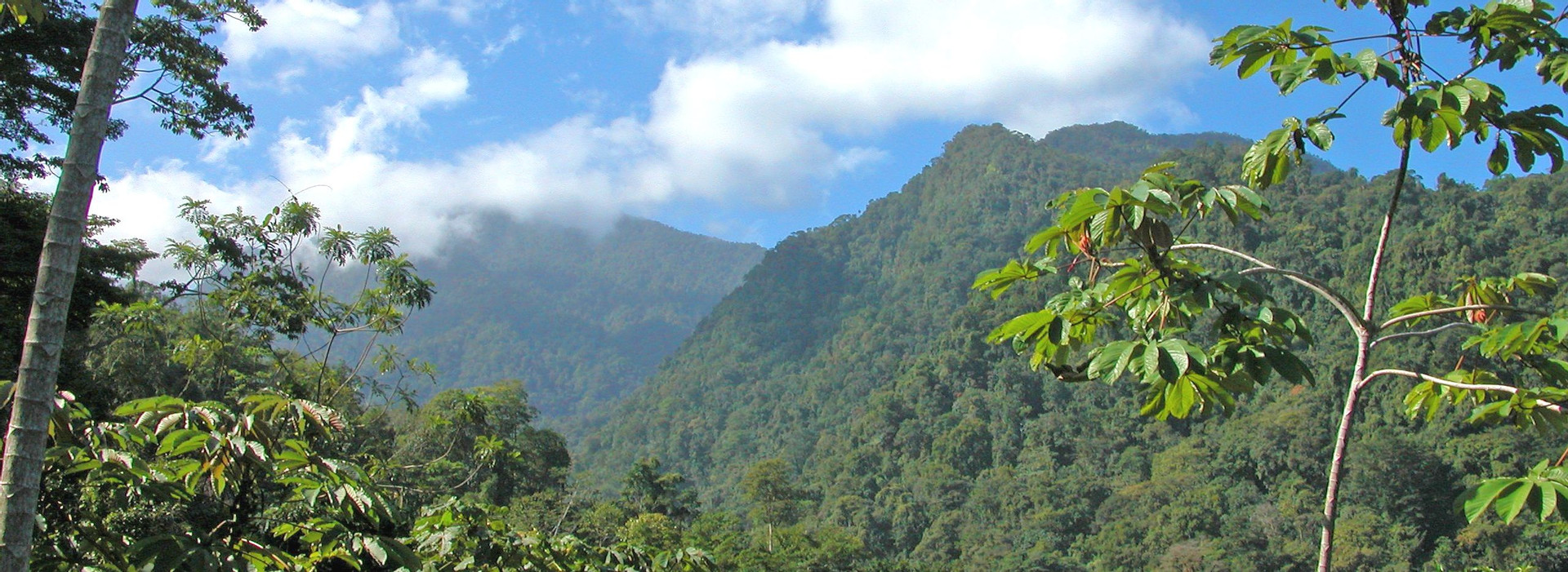Violet-crowned Woodnymph
Honduras - The Lodge at Pico Bonito
 By Dominic Couzens
By Dominic Couzens18th August 2020
Dominic is a Naturetrek tour leader and one of Britain's
best known and most prolific natural history writers.
Where would you like to go when the madness finally ends? Speaking for myself, I would like to return to where I was when it began. I was staying at a luxury tropical lodge, where I could watch hummingbirds bathing on leaves during an intense rain shower, where the birds had complicated but descriptive names like Streak-headed Woodcreeper, and where your major concern each day was merely making sure you could catch up with every species in a fast-moving flock of forest jewels.
Away from the balconies, the garden shrubbery is full of colourful sprites such as the Olive-backed Euphonia, a far more attractive bird than its sounds, the ubiquitous Great Kiskadee, the Lesson’s Motmot and the Red-capped Manakin, a fruit-eater with a jet-black body, scarlet head, a staring white eye and, absurdly, what look like yellow pantaloons. Overhead fly White-fronted Parrots, calling noisily, and by contrast so do silent, slow-flapping Keel-billed Toucans. Uncommon birds turn up all the time; one of my lunches was interrupted by seeing a Tawny-winged Woodcreeper at a nest-hole.
The accommodation is luxurious here, in widely-spaced individual cabins. Mine, I was told, was close to the territory of a Slaty-breasted Tinamou, as if this bird was a personal feature. I could almost count the steps from my cabin to the main Tower Hide, which gives an incredible view of the Pico Bonito National Park, right down to the lowlands and the Caribbean coast. I could thus count the steps to an almost certain sighting of one of Central America’s most sought-after birds, the Lovely Cotinga, individuals of which were forever perched just across the river, in tall fruiting trees. The males are shining cobalt-blue with a purple pear-shaped mark on the breast, almost over-opulent and exaggerated. These mysterious birds eat fruit and then just disappear into the forest; the nest has only been found once or twice.
The forest around the Lodge abounds with birds and other animals. The area bird list is well over 400 species, and there are dozens of trails that you can follow, some of them providing a whole day of walking, with the prospect of near-legendary species such as Tawny-faced Quail and a suite of rare Antbirds. You hardly have to go any distance at all for such delights as Great Potoo and Great Curassow, exciting birds that are often tricky elsewhere. To be honest, this would have been the ideal place to be locked down for a few months.
Pico Bonito is the perfect base for some day trips, though. Everybody goes half an hour down the river to visit the Cuero y Salado Wildlife Refuge, named for the two rivers that join together and meet the ocean here. It is a compelling place, a maze of mangroves and lush waterside vegetation, overlooked by Honduras’ coastal mountain range. You travel in a small boat and wonder at it all. The odd Sungrebe may swim past, looking like a Moorhen painted by Salvador Dali, while Mantled Howler Monkeys grunt and groan like the soundtrack to a hurricane movie. The American Crocodiles just lie there, with menace. The birds include Mangrove Cuckoo, the tricky American Pygmy Kingfisher, Boat-billed Herons, Limpkins and, when the fancy takes them, Magnificent Frigatebirds deign to float over. And just to get here you have to get on a tiny train, painted bright yellow, a narrow-gauge track of 9 kilometres, which was built 100 years ago. It is a rare train that stops for good birds, a Jabiru in my case.

Channel-billed Toucan

Great Curassow

Violet Sabrewing
Another fabulous trip is to Lancetilla Botanic Gardens, in the coastal town of Tela. It is huge and contains not just plantings, but a significant amount of natural rainforest. The roads make birding easy, although my visit was affected by heavy rain. There are some great birds here, including one of my favourite hummingbirds, the Purple-crowned Fairy. There was an excellent selection of North American migrants revelling in the lush treetops, plus delights such as Black-headed Trogon, Olivaceous Piculet and Rose-throated Becard. My guide told me the story of the man who founded the Botanic Garden and ran it for years; apparently he was a Henry VIII type, who managed to get through half a dozen wives by making sure they unfortunately ‘disappeared’ when he was fed up with them. I have no idea whether this is true!
The longer day trip that everyone must do from Pico Bonito is venturing to the dry forest of the Rio Aguan Valley to the east, where you can catch up with the only species that is actually endemic to the country, the Honduran Emerald. It is quite a feat for a small country with many close neighbours to boast any endemic at all, and the Honduran Emerald, with its white-scaled emerald throat, is a distinctive bird. Unfortunately endangered, it lives in this unusual drier rain-shadow region with its desert-like scrub, haunt of other great birds such as Lesser Roadrunner and White-lored Gnatcatcher. It is a long trip, but well worth the effort.
The great thing about Pico Bonito, though, is that you come back to drinks on the veranda and a fabulous restaurant. There is a spa and a swimming pool, all contributing to the Lodge being one of the Small Luxury Hotels of the World Group. It is a perfect stepping stone for a novice birder to get an idea of the barely credible diversity of Central America, while also enjoying restful comfort.
You might never have considered Honduras as a place to visit, but I guarantee you will be surprised. If you do visit, if I had my wish, I would meet you there.



 Loading search...
Loading search...

